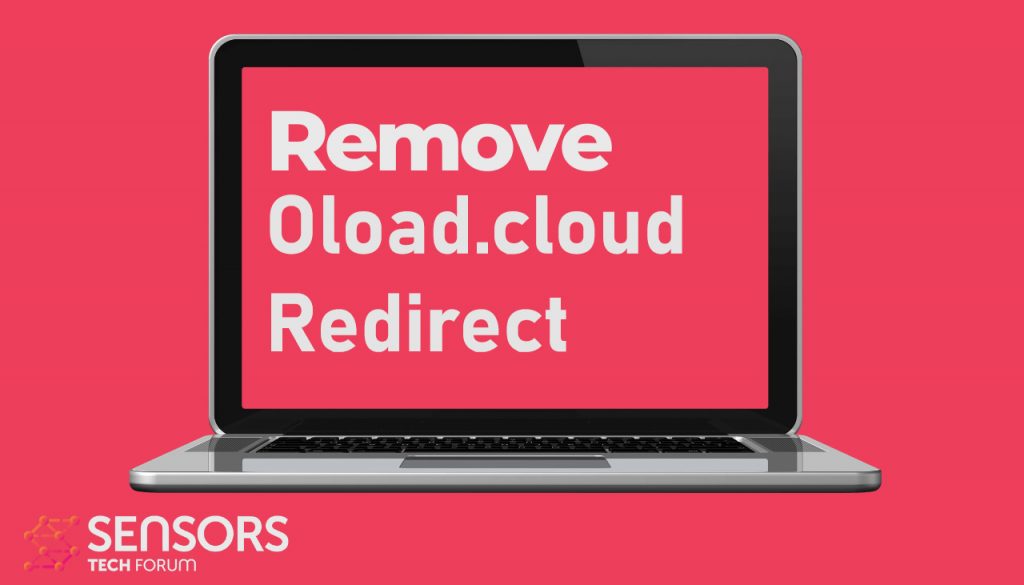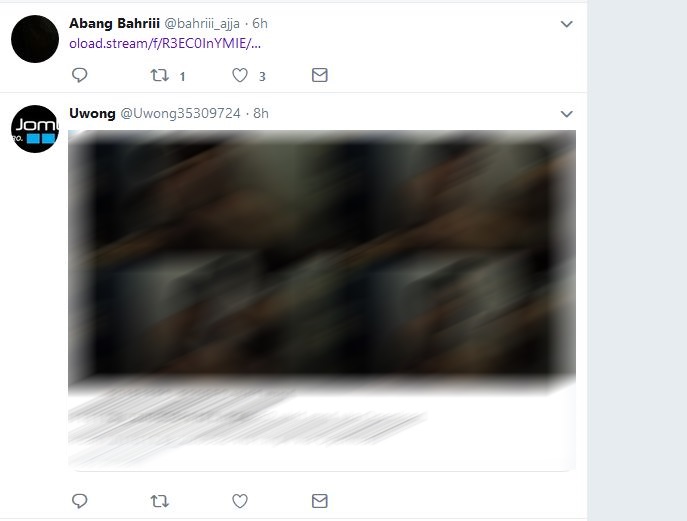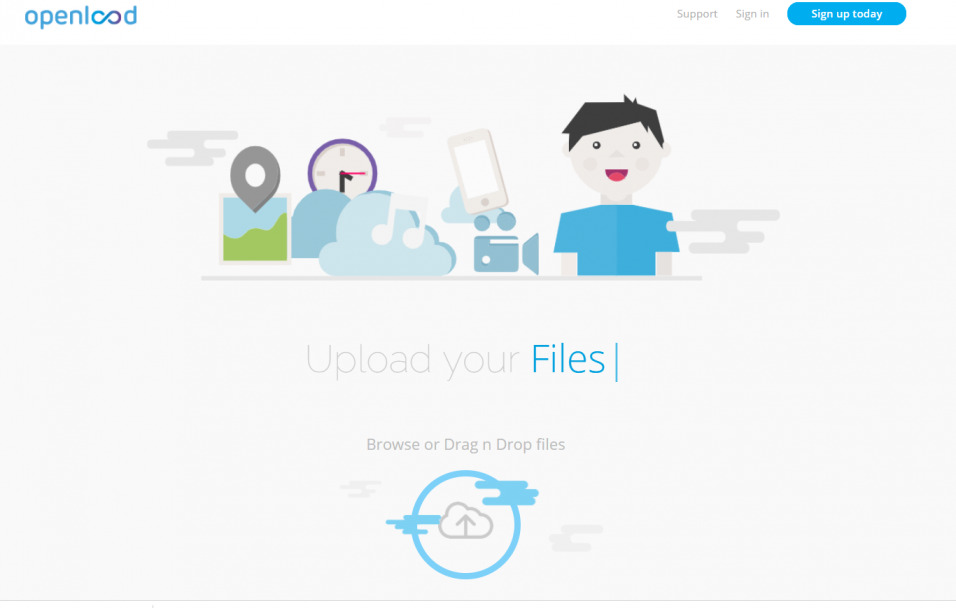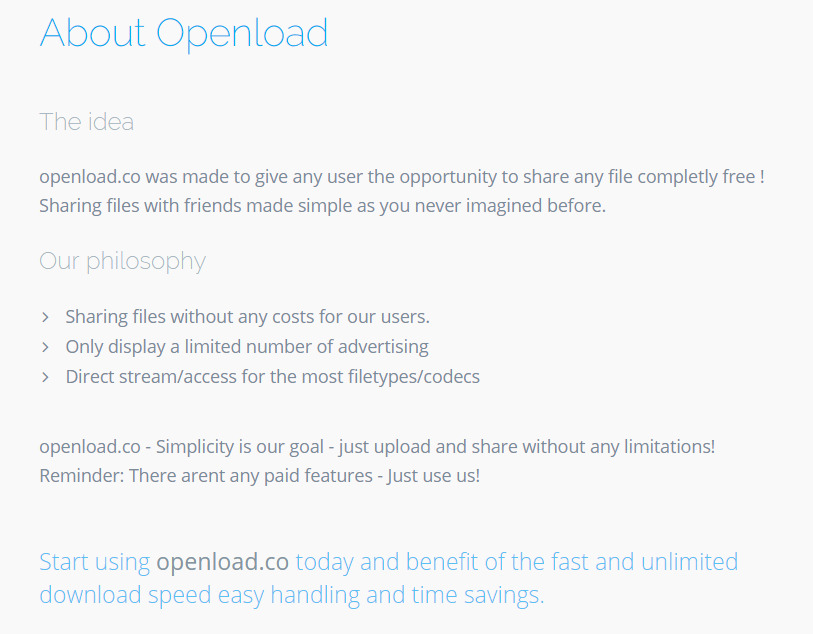Oload.cloud Redirect
 The main objective of this article is to describe what is the Oload.cloud redirect and how to remove it from your Mac or PC successfully plus make sure to prevent ads from appearing in the future.
The main objective of this article is to describe what is the Oload.cloud redirect and how to remove it from your Mac or PC successfully plus make sure to prevent ads from appearing in the future.
Oload.cloud is an online file sharing site that declares it can allow customers to share any type of information, files and other documents without paying. But every one of these extras and services comes at our expense, because you may begin to see a substantial number of ads on your computer system. The Oload.cloud “Virus” is likewise the kind of program that intends to connect users to the oload servers which might trigger different kinds of third-party type on computers. If you keep seeing Oload.cloud to instantly be loaded up on your browser and if your PC or Mac is working slow, you probably should read this short article as it will help you to remove the Oload.cloud ads from it.

Threat Summary
| Name | Oload.cloud |
| Type | Browser Hijacker |
| Short Description | Aims to modify the settings on your web browser in order to get it to cause browser redirects and display different advertisements. |
| Symptoms | Your web browser begins to display various types of online advertisements, which results in slowing down of your PC. |
| Distribution Method | Bundled downloads. Web pages which may advertise it. |
| Detection Tool |
See If Your System Has Been Affected by malware
Download
Malware Removal Tool
|
User Experience | Join Our Forum to Discuss Oload.cloud. |
Oload.cloud Ads – What Does It Do
A new Oload.cloud wa of distriution has been identified on Twitter utilizing both hacked or hacker-made customer profiles. They send out tweets containing adult pictures or other clickbait type of content that the customers might discover fascinating. Upon clicking the web link they will certainly be rerouted to the pop-up website as the image below shows:
Hyperlinks on social media networks are really reliable at getting to huge masses. A crucial way of infection is making use of hashtags which have the ability of connecting thousands of users as soon as the blog posts are posted to the network automatically.
The software application, responsible for you beginning to see the Oload.cloud web pages or advertisements has been created with the idea in mind that it acts to be helpful and useful app. Such programs usually pose as apparently legit kind of programs whose primary goal is to either be downloaded from internet sites or be bundled along with various other third-party programs. Such programs are usually free media player software, data converters or various other apparently genuine freeware applications.
When users download and install apps, like those ones, they may encounter the same app that is triggering the Oload.cloud domain to pop-up in the form of an “optional add-on” added to the current setup procedure. And also it is challenging to find them either, due to the fact that they are typically located in the “Personalized” or “Advanced” installation modes.
Once it has already been installed on your computer, the undesirable program that has something to do with Oload.cloud adware may trigger a web browser redirect to the own home web page of this “service”, which may resemble the following:
The end result of this is that website traffic is starting to sum up on the Oload service. And also on their websites, the firm behind this “service” admits to utilizing different kinds of advertisements:
As soon as Oload.stream has begun displaying ads onto customers computer systems, the ads may be of different types:
- Redirects.
- Pop-ups.
- Ad-supported search results page.
- Highlighted message ads.
- On-line banners.
In addition to this, the Oload services have been discovered to make use of misleading privacy policy methods where they do state that they accumulate certain sorts of data from the visitors’ computer systems and they may process that data.
To sum it up, there are several key points which you need to know concerning the Oload.cloud services:
- Oload might get the information you have submitted somehow by adjusting their Privacy Policy.
- The ads may reroute you to harmful websites that might make your PC infected with malware.
- You might start to see various different sorts of advertisements that might lead you to store websites that may be fake ones.
The advertisements may lead to techn assistance and other online scam websites. - You may experience browser redirects to phishing web pages that act to be real login websites, like Facebook, Google, etc.

Remove Oload.cloud Ads from your PC or Mac
If you desire to eliminate these ads totally from your computer, we advise that you follow the elimination directions underneath this post. They have actually been split in manual or automated removal techniques and the objective is to get you to attempt to remove the program by yourself. But if you continue to see numerous types of ads and reroutes to Oload.cloud on your browser, then specialists do suggest to count on a professional anti-malware. Such tool has the sufficient ability of conducting a complete scan of your PC or Mac and removing all invasive and adware-related data plus objects, while ensuring that future defence is taking place.
- Windows
- Mac OS X
- Google Chrome
- Mozilla Firefox
- Microsoft Edge
- Safari
- Internet Explorer
- Stop Push Pop-ups
How to Remove Oload.cloud from Windows.
Step 1: Scan for Oload.cloud with SpyHunter Anti-Malware Tool



Step 2: Boot Your PC In Safe Mode





Step 3: Uninstall Oload.cloud and related software from Windows
Uninstall Steps for Windows 11



Uninstall Steps for Windows 10 and Older Versions
Here is a method in few easy steps that should be able to uninstall most programs. No matter if you are using Windows 10, 8, 7, Vista or XP, those steps will get the job done. Dragging the program or its folder to the recycle bin can be a very bad decision. If you do that, bits and pieces of the program are left behind, and that can lead to unstable work of your PC, errors with the file type associations and other unpleasant activities. The proper way to get a program off your computer is to Uninstall it. To do that:


 Follow the instructions above and you will successfully uninstall most programs.
Follow the instructions above and you will successfully uninstall most programs.
Step 4: Clean Any registries, Created by Oload.cloud on Your PC.
The usually targeted registries of Windows machines are the following:
- HKEY_LOCAL_MACHINE\Software\Microsoft\Windows\CurrentVersion\Run
- HKEY_CURRENT_USER\Software\Microsoft\Windows\CurrentVersion\Run
- HKEY_LOCAL_MACHINE\Software\Microsoft\Windows\CurrentVersion\RunOnce
- HKEY_CURRENT_USER\Software\Microsoft\Windows\CurrentVersion\RunOnce
You can access them by opening the Windows registry editor and deleting any values, created by Oload.cloud there. This can happen by following the steps underneath:


 Tip: To find a virus-created value, you can right-click on it and click "Modify" to see which file it is set to run. If this is the virus file location, remove the value.
Tip: To find a virus-created value, you can right-click on it and click "Modify" to see which file it is set to run. If this is the virus file location, remove the value.
Video Removal Guide for Oload.cloud (Windows).
Get rid of Oload.cloud from Mac OS X.
Step 1: Uninstall Oload.cloud and remove related files and objects





Your Mac will then show you a list of items that start automatically when you log in. Look for any suspicious apps identical or similar to Oload.cloud. Check the app you want to stop from running automatically and then select on the Minus (“-“) icon to hide it.
- Go to Finder.
- In the search bar type the name of the app that you want to remove.
- Above the search bar change the two drop down menus to “System Files” and “Are Included” so that you can see all of the files associated with the application you want to remove. Bear in mind that some of the files may not be related to the app so be very careful which files you delete.
- If all of the files are related, hold the ⌘+A buttons to select them and then drive them to “Trash”.
In case you cannot remove Oload.cloud via Step 1 above:
In case you cannot find the virus files and objects in your Applications or other places we have shown above, you can manually look for them in the Libraries of your Mac. But before doing this, please read the disclaimer below:



You can repeat the same procedure with the following other Library directories:
→ ~/Library/LaunchAgents
/Library/LaunchDaemons
Tip: ~ is there on purpose, because it leads to more LaunchAgents.
Step 2: Scan for and remove Oload.cloud files from your Mac
When you are facing problems on your Mac as a result of unwanted scripts and programs such as Oload.cloud, the recommended way of eliminating the threat is by using an anti-malware program. SpyHunter for Mac offers advanced security features along with other modules that will improve your Mac’s security and protect it in the future.
Video Removal Guide for Oload.cloud (Mac)
Remove Oload.cloud from Google Chrome.
Step 1: Start Google Chrome and open the drop menu

Step 2: Move the cursor over "Tools" and then from the extended menu choose "Extensions"

Step 3: From the opened "Extensions" menu locate the unwanted extension and click on its "Remove" button.

Step 4: After the extension is removed, restart Google Chrome by closing it from the red "X" button at the top right corner and start it again.
Erase Oload.cloud from Mozilla Firefox.
Step 1: Start Mozilla Firefox. Open the menu window:

Step 2: Select the "Add-ons" icon from the menu.

Step 3: Select the unwanted extension and click "Remove"

Step 4: After the extension is removed, restart Mozilla Firefox by closing it from the red "X" button at the top right corner and start it again.
Uninstall Oload.cloud from Microsoft Edge.
Step 1: Start Edge browser.
Step 2: Open the drop menu by clicking on the icon at the top right corner.

Step 3: From the drop menu select "Extensions".

Step 4: Choose the suspected malicious extension you want to remove and then click on the gear icon.

Step 5: Remove the malicious extension by scrolling down and then clicking on Uninstall.

Remove Oload.cloud from Safari
Step 1: Start the Safari app.
Step 2: After hovering your mouse cursor to the top of the screen, click on the Safari text to open its drop down menu.
Step 3: From the menu, click on "Preferences".

Step 4: After that, select the 'Extensions' Tab.

Step 5: Click once on the extension you want to remove.
Step 6: Click 'Uninstall'.

A pop-up window will appear asking for confirmation to uninstall the extension. Select 'Uninstall' again, and the Oload.cloud will be removed.
Eliminate Oload.cloud from Internet Explorer.
Step 1: Start Internet Explorer.
Step 2: Click on the gear icon labeled 'Tools' to open the drop menu and select 'Manage Add-ons'

Step 3: In the 'Manage Add-ons' window.

Step 4: Select the extension you want to remove and then click 'Disable'. A pop-up window will appear to inform you that you are about to disable the selected extension, and some more add-ons might be disabled as well. Leave all the boxes checked, and click 'Disable'.

Step 5: After the unwanted extension has been removed, restart Internet Explorer by closing it from the red 'X' button located at the top right corner and start it again.
Remove Push Notifications from Your Browsers
Turn Off Push Notifications from Google Chrome
To disable any Push Notices from Google Chrome browser, please follow the steps below:
Step 1: Go to Settings in Chrome.

Step 2: In Settings, select “Advanced Settings”:

Step 3: Click “Content Settings”:

Step 4: Open “Notifications”:

Step 5: Click the three dots and choose Block, Edit or Remove options:

Remove Push Notifications on Firefox
Step 1: Go to Firefox Options.

Step 2: Go to “Settings”, type “notifications” in the search bar and click "Settings":

Step 3: Click “Remove” on any site you wish notifications gone and click “Save Changes”

Stop Push Notifications on Opera
Step 1: In Opera, press ALT+P to go to Settings.

Step 2: In Setting search, type “Content” to go to Content Settings.

Step 3: Open Notifications:

Step 4: Do the same as you did with Google Chrome (explained below):

Eliminate Push Notifications on Safari
Step 1: Open Safari Preferences.

Step 2: Choose the domain from where you like push pop-ups gone and change to "Deny" from "Allow".
Oload.cloud-FAQ
What Is Oload.cloud?
The Oload.cloud threat is adware or browser redirect virus.
It may slow your computer down significantly and display advertisements. The main idea is for your information to likely get stolen or more ads to appear on your device.
The creators of such unwanted apps work with pay-per-click schemes to get your computer to visit risky or different types of websites that may generate them funds. This is why they do not even care what types of websites show up on the ads. This makes their unwanted software indirectly risky for your OS.
What Are the Symptoms of Oload.cloud?
There are several symptoms to look for when this particular threat and also unwanted apps in general are active:
Symptom #1: Your computer may become slow and have poor performance in general.
Symptom #2: You have toolbars, add-ons or extensions on your web browsers that you don't remember adding.
Symptom #3: You see all types of ads, like ad-supported search results, pop-ups and redirects to randomly appear.
Symptom #4: You see installed apps on your Mac running automatically and you do not remember installing them.
Symptom #5: You see suspicious processes running in your Task Manager.
If you see one or more of those symptoms, then security experts recommend that you check your computer for viruses.
What Types of Unwanted Programs Are There?
According to most malware researchers and cyber-security experts, the threats that can currently affect your device can be rogue antivirus software, adware, browser hijackers, clickers, fake optimizers and any forms of PUPs.
What to Do If I Have a "virus" like Oload.cloud?
With few simple actions. First and foremost, it is imperative that you follow these steps:
Step 1: Find a safe computer and connect it to another network, not the one that your Mac was infected in.
Step 2: Change all of your passwords, starting from your email passwords.
Step 3: Enable two-factor authentication for protection of your important accounts.
Step 4: Call your bank to change your credit card details (secret code, etc.) if you have saved your credit card for online shopping or have done online activities with your card.
Step 5: Make sure to call your ISP (Internet provider or carrier) and ask them to change your IP address.
Step 6: Change your Wi-Fi password.
Step 7: (Optional): Make sure to scan all of the devices connected to your network for viruses and repeat these steps for them if they are affected.
Step 8: Install anti-malware software with real-time protection on every device you have.
Step 9: Try not to download software from sites you know nothing about and stay away from low-reputation websites in general.
If you follow these recommendations, your network and all devices will become significantly more secure against any threats or information invasive software and be virus free and protected in the future too.
How Does Oload.cloud Work?
Once installed, Oload.cloud can collect data using trackers. This data is about your web browsing habits, such as the websites you visit and the search terms you use. It is then used to target you with ads or to sell your information to third parties.
Oload.cloud can also download other malicious software onto your computer, such as viruses and spyware, which can be used to steal your personal information and show risky ads, that may redirect to virus sites or scams.
Is Oload.cloud Malware?
The truth is that PUPs (adware, browser hijackers) are not viruses, but may be just as dangerous since they may show you and redirect you to malware websites and scam pages.
Many security experts classify potentially unwanted programs as malware. This is because of the unwanted effects that PUPs can cause, such as displaying intrusive ads and collecting user data without the user’s knowledge or consent.
About the Oload.cloud Research
The content we publish on SensorsTechForum.com, this Oload.cloud how-to removal guide included, is the outcome of extensive research, hard work and our team’s devotion to help you remove the specific, adware-related problem, and restore your browser and computer system.
How did we conduct the research on Oload.cloud?
Please note that our research is based on independent investigation. We are in contact with independent security researchers, thanks to which we receive daily updates on the latest malware, adware, and browser hijacker definitions.
Furthermore, the research behind the Oload.cloud threat is backed with VirusTotal.
To better understand this online threat, please refer to the following articles which provide knowledgeable details.





